Well, I am stupid.
When I designed the first polargraph gondola (above) I thought I was being clever by making the gondola arms (the cords) pivot around a central axis. So this is what I did:
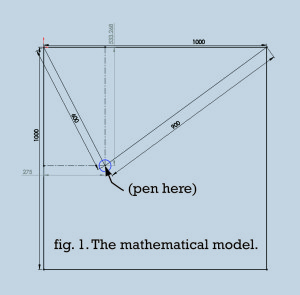 There’s no room for error. The physical machine reflects the mathematical model. Sure it’d be much easier to make the cords pivot from points just outside the pen itself. Easier to design, easier to build, and cheaper, far, far cheaper. But surely, says I, to do that would end in madness! Dogs and cats living together indeed!:
There’s no room for error. The physical machine reflects the mathematical model. Sure it’d be much easier to make the cords pivot from points just outside the pen itself. Easier to design, easier to build, and cheaper, far, far cheaper. But surely, says I, to do that would end in madness! Dogs and cats living together indeed!:
I mean! How could anyone accept that. The distance from the notional tip of the hanging triangle and the actual pen itself changes constantly! Puny humans!
Well, I knew that couldn’t really be true, otherwise how come those gondolas didn’t exhibit hideous geometric distortions? Like when I used Stuart Childs’s gondola on the Spectrum Arts window? Ah, don’t think about that, revel in your technical superiority with your elegant radially symmetrical design. It must have been some weird abberation to do with the size of the surface. Well done lad.
And maybe just think for a moment, or better still, draw some diagrams to prove the theory:
Aw nuts. The offset arms fallacy (as I’m calling it) relies on a deeply brainless piece of thinking. The idea that the hanging triangle always exists, but that the gondola is somehow squeezed up the cords until it finds equilibrium, suspended in that V (fig 2). As fig 3 shows, that’s cart-before-horse stuff.
AHA, but I still have you! The gondola won’t hang straight all the time – as it traverses the surface, its orientation will change. It’ll be all over the place! HA!
Double nuts. BUT, well. Ha, you thought you had me. Well, what happens when you’ve got one swing arm joint slightly looser than the other? Now that’s dangerous territory.
Ok, that’s the worst case I can think up. With an offset swing-arm design, for any given pair of cord lengths, the actual position of the axis could be off by half the intra-arm-pivot distance.
So forgive me. This was prompted by Makerblock’s lucid response to my childish chest-beating on his blog. I don’t know why it took me so long to actually figure this out.
The reason it took so long to figure this out:
Well, the reason this fallacy stuck so long in my head is that I was thinking badly. I worked on the basis that the machine knows the shape of the triangle. Therefore it knows the angles of the sides, and the positions of the intersections. But of course it doesn’t. All it knows is the length of the sides, and it’s got to figure the rest out from that.
If it somehow knew the angles of the hanging strings, then my misconception would be entirely apt. It would entirely miscalculate the position of the gondola, based on where it thought the tip of the triangle way. So it does make sense, after a fashion.
This is an interesting case that illustrates one of the problem with the kind of naive (or isolated) engineering that I do. It provides the opportunity to simplify things, and get by on “just good enough to work”, but also tolerates faulty thinking (for better or for worse), and if anything gets built on top of faulty thinking, that can end up messy.
I’m still not changing it though. Central axis FTW!

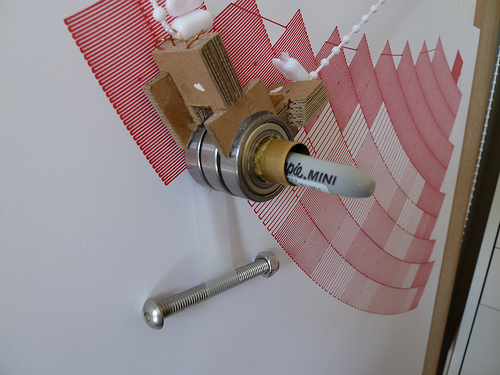
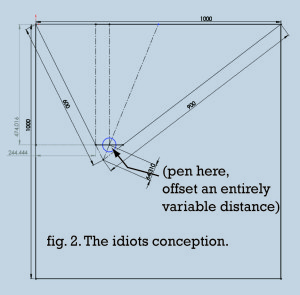
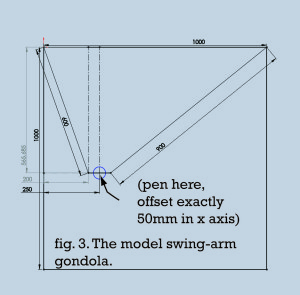
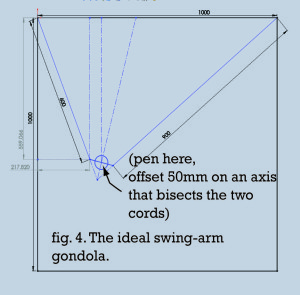
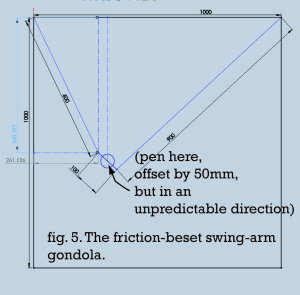
With the pen at the convergence point you get one or two more drawable inches up at the top of the machine, where it draws more accurately. I think. (Sandy’s self-doubt in this post is contagious).
Sure, with the pen lower you can draw that amount lower, but the gondola is all wibbly-wobbly down there. Who needs that?
I got a bad grade in Geometry (a cute girl sat next to me – long story), so I’ll trust the rest of you to work out that aspect of the argument.
I just noticed that your drawings have the tow points to the side of the pen, not above like most of the gondola variants I’ve seen. My previous comment was regarding those variants, not the case you’ve illustrated. The one you’ve illustrated could draw slightly higher than the standard polargraph gondola, potentially. I think.
Moving the pen a fixed offset higher does mean that I could draw a little higher, but it also means the whole “sweet spot” is higher too, doesn’t increase the size of the spot, just moves it.
I think the issue with any offset arm gondola is that the orientation of the gondola itself becomes important, and that is never going to be predictable because it’s controlled by friction of the pen against the paper, the pivot joints, even the stiffness of the cords. The reason I use expensive ball bearings on the polargraph gondola is not for weight, it’s to remove any impediment to the arms turning. In principle they should always be in-line with the cords.
In practice that’s not the case, there are still occasions where I see the angle of the cords change, the and the angle of the arms on the gondola lags behind because the force on them is not yet great enough to overcome the initial resistance. This causes the pen tip to be dragging behind where the true tip of the triangle is, by a tiny bit.
I don’t genuinely think it makes any difference in a way that is a problem. I’m joking in this post because my awesome discovery is clearly something that everybody else already knew (and had probably already patiently explained to me). It’s a commentary on my style of working or thinking, and is funny because it reveals how reluctant I am sometimes to actively rock the boat when it means challenging ideas that I like.
These machines (for me) are about reveling in the inaccuracies and the foibles, the peculiar little physical tics that differentiate one machine from another. They’re about seeing the process in the result – seeing “the hand of the creator” (the machine) in the shape of the lines. If it were perfect every time, well, just use a printer.
Hi Sandy, I’m new to this and about to embark on my first attempt at building. Your website has been a great resource so far to get started.
A query about the gondola though – I notice you’ve got three bearings in the gondola – and I can see in your original gondola pictured at the top of this thread what the purpose of these 3 was – with the right hand cord linked to the centre bearing, and the left hand cord connected to the top and bottom bearings, they’re both pulling at the same point on the pen, which means the pen should stay straight. against the paper when its traversing the page.
In your current kit though, you’ve still got the 3 bearings, but watching your video, only 2 of these have arms connected to them.
I’m assuming you’re using 2 arms rather than three as the addition of the round plate now means that the pen is kept flat against the page, and connecting a third arm in the same configuration as your original is now redundant. Is that the case? Did you find that having the cords pulling at slightly different points on the pen doesn’t really make a differences?
And secondly, if you’ve got 2 arms instead of 3, isn’t the third bearing now redundant also? Watching your gondola assembly video, I couldn’t make out what the bottom bearing was doing, other than acting as a spacer – unless I’m missing something.
I totally agree with your observation on the “friction-beset” gondola. Even if you had the exact same friction on each pivot of the arm, I was thinking if you had a long horizontal line where you could get the speed up, you might also see the gondola swinging as it accelerates/decelerates along the vector.
Thanks again for your content,
Andrew
Hi Andrew – good spot on the double attachment on the old cardboard gondola. That was necessary because the cardboard and the glue didn’t have the strength to cantilever over so that the attachment point was in line with the other attachment point. It needed support from both ends.
It doesn’t have anything to do with keeping the gondola stable, or flat though, having only one fastening to the tube /bearing doesn’t change the centre of gravity of the gondola, and doesn’t make any difference to the stability. It takes a bit of a leap to think about it, but the shape of the arm that links the tube to the cord doesn’t matter at all, it’s the position of the attachment point with regards to the tube that makes the difference. So the cords are still pulling in line, on the same point.
The third bearing is redundant as a bearing, yes, you’re right, you’re not missing anything. It’s there as a weight, and that’s really all. The cord attaches on an axis that runs down the centre of the middle bearing, so to hang straight, there needs to be equal weight on both sides, and keeping a bearing there was the simplest way to do it.
In practice there is almost always more weight on the back side (the end facing out) because the tubing is slightly longer, and even though the pen is light, it sticks out a long way. So I often stick an extra bit of weight (like a bag of pennies) on the stabiliser if it’s important to me that I get sharp corners.
You’re very welcome – happy to help 🙂
sn